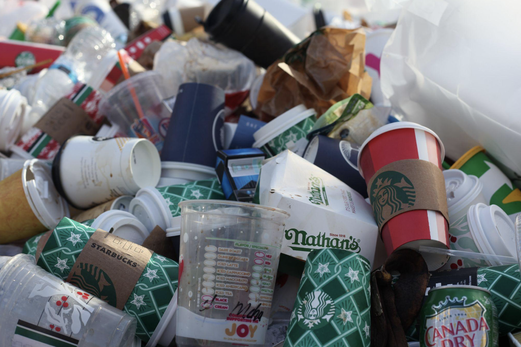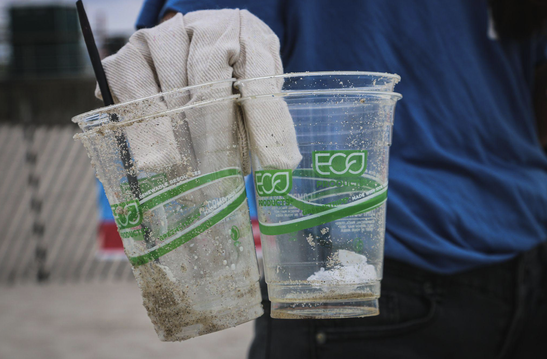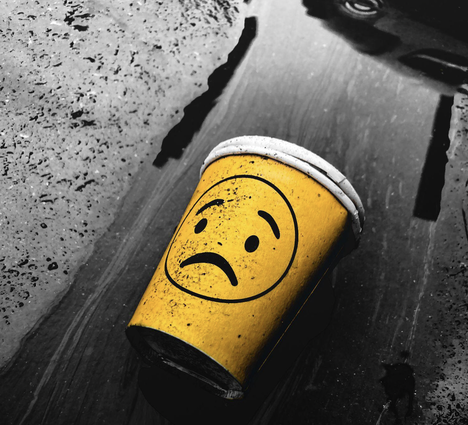|
When you order an iced coffee at Starbucks, do you keep the coffee cup? For many people, this is a no-brainer. In fact, many consumers may now be wondering whether their drink bought in a paper cup has any eco-friendly benefits whatsoever? It turns out that these disposable cups are not so eco-friendly, which leads many environmentalists to call them “coffee cup pollution.” The throwaway culture of non-recyclable coffee cups Coffee drinkers around the world have been finding out the hard way that their paper cups aren't actually recyclable at all - no matter how many times they have been told by coffee chains. And this isn't just a problem for those of us who take beverages out on the go - as more and more people are using drive-through service as well as home delivery from shops such as Starbucks Coffee. It is estimated that 2.5 billion coffee cups are tossed away each year, taking up landfill space and adding to pollution. In addition, these paper-based products take over 500 years to decompose. With about 5000 cups trashed away every minute, it is important for us to do what we can to reduce this number and protect the environment from pollutants like BPA and DEHP, which are found in paper products. And if that wasn't bad enough for their environment, they also contribute to climate change because they're made from nonrenewable resources like crude oil and natural gas, which release greenhouse gases into our atmosphere during its production, distribution, and disposal. Also, they require virgin materials such as trees. Therefore, it's time for us to be more conscious about what we use when taking our morning coffee break! The coffee cup pollution is a real thing I'm sure all coffee drinkers are aware that their Starbucks cups or any other paper coffee cups are almost always coated with a thin layer of plastic. This immediately rules out any possibility that these paper cups can be recycled. Only less than 1% of coffee cups are being recycled. We also know that the plastic coating on the outside of coffee cups cannot be broken down either, so instead, it falls into our world as waste or dumped into waterways. This problem is getting worse because coffee cups have become ubiquitous in the modern world, but fewer people recycle them. And even when you try recycling - it's impossible to repurpose the paper for anything useful. It is estimated that an individual can use up to 300 disposable cups in their lifetime. It is estimated that Americans use 50 billion coffee cups each year, or enough for every person on earth to have 10 cups each. That's not even counting all the other paper products we waste! Coffee cup pollution is a real thing. The truth is that paper cups are not-so-eco-friendly. This also means they are bad for your wallet because you have to keep shelling out for new ones rather than recycling them or reusing them again until they are totally worn out. Coffee cup pollution has a significant effect on the environment If you don’t see why disposable coffee cups are such an environmental disaster, here are the top ten environmental impacts of coffee cup pollution. And some simple lifestyle changes that you can adopt to make a difference. Coffee cups are lined with polyethylene Although disposable coffee cups are made from paper, the biggest concern is the lining of a particular type of plastic called polyethylene. Coffee cups are lined to make them waterproof and leakage proof so they can hold your drinks; however, the same material makes them hard to dispose of. Recycling coffee cups isn't an option No matter how relieved you're after knowing your coffee won't be leaking out of your plastic-lined cup or spotting the white shirt you've worn for an interview, the plastic lining cannot be removed or recycled. This means the chances are very thin that your takeaway coffee cup will be recycled. For this very reason, only 1 in 400 disposable coffee cups are recycled; the remaining just end up at landfill sites. Billions of coffee cups add to the piles of waste every year A coffee cup laying around the ground has become a common sight. You'd be surprised to know that over 50,000 disposable coffee cups are thrown away every day. This creates visual pollution and also adds to the billions of sine-use waste that is dumped in our oceans. The trouble with coffee cup accessories While we are talking about coffee cup pollution, let's also consider the single-use coffee accessories, such as straws, stirrers, lids, and paper sleeves which are used to hold the coffee cup. All of these things we can do well without! Plastic lids are usually made from polypropylene or polystyrene that is hard to recycle and even more expensive than creating new lids. The so-called environmental milestone of Starbucks, the straw-free sippy cups, used between .32 to .88 grams of more plastic than the straws they prevented from getting into the marine ecosystem. A better approach would be to skip the lid altogether. Plastic takes ages to decompose The coffee cup you used today will stay on this planet long after you have been decomposed. It takes over 500 years to decompose. It's better left undecomposed The thin polyethylene lining inside the paper cup breaks down into microplastics. Microplastics are tiny fragments of size less than 5mm. And, if you have watched Blue Planet 2, you know what happens next! These tiny particles enter our water systems, where marine animals often mistake them for food. While this gives them a sense of fulfillment, it starves them to death. This is also disrupting food chains in our ecosystem. A professor from the School of Biological and Marine Sciences at the University of Plymouth has reported microplastics in every third of fish caught in the UK. They have already entered our food chain! Plastic isn't the only thing you'd be concerned about Since they are non-recyclable, single-use paper cups need fresh paper pulp, which means there'd be fewer trees. According to one estimate, over 2000,000 trees are chopped down per year to keep up with the takeaway coffee cup demand in the UK alone. All these trees are laid down only to create a product that will be littered as soon as you take the final sip of your latte. This also raises concerns for carbon dioxide in the atmosphere that'd otherwise be absorbed. Forever increasing pollution levels increases from cup to carbon dioxide While the annual loss of millions of trees reduces the number of potential carbon dioxide sinks, the levels are exacerbated by producing one pound of carbon dioxide per four coffee cups. This is heavily contributing to global warming and climate change. And we haven’t yet taken into consideration the contribution to methane, a climate-pollutant gas, at landfill sites. It's consuming valuable resources as well In a report issued by Clean Water Action, it is estimated that manufacturing coffee cups exhausts more of natural resources (water & energy) than conventional plastic. At landfills, it leaches toxic fossil byproducts that contaminate soil and water and pose health hazards to humans and wildlife. Psychology at its worst People attach status symbols to just about anything nowadays. These days with the coffee brands, it's very prevalent. People posting selfies with the cups from expensive coffee franchises is what has helped nurture this culture. And it's funny in a sense people are paying way too much for a cup of coffee that they can buy from local joints or even use a reusable mug. A branded, single-use cup thrown away after posting a selfie on their social media doesn't make sense! This hits hard on your pockets as well. Together we can make a difference! The responsibility to beat coffee cup pollution, or plastic pollution in broader terms, lies with both parties. The coffee shop that is selling the single-use coffee cup and the consumer buying it needs to work together. Only then will it be possible to reduce this source of environmental nuisance. Reusable cups to the rescue Just as an insignificant single-use product as a straw or cup can drastically impact the environment, a simple swap can have a considerable positive impact on the environment as well. There are eco-friendly alternatives to paper-based coffee cups that can help. However, we need to wean ourselves off relying on disposable cups. For now, let's start by making sure you use a reusable mug with a lid. Reusable cups are better alternatives to good-for-nothing single-use coffee cups. And ceramic or glass cups look even cooler! It can significantly reduce greenhouse gas emissions between 37 and 47 percent and reduce the waste in the landfills by over 80 percent. Isn’t that worth it? Discount can help decrease coffee cup pollution Coffee shops around the world are now becoming more conscious of their plastic and carbon footprints. Coffee drinkers can also bring their own paper cups from home to fill up at their coffee shop, which is a perfect way to reduce all of these levels of waste. While some coffee shops like Starbucks encourage bringing your own reusable coffee cup by offering discounts, others leverage customers to buy their reusable cup for a discounted price. A win-win situation for all! You can even eat Cupffee's edible cup after your last sip of coffee. Biodegradable is the new normal No one can adopt a zero-waste lifestyle overnight. But one can take small steps towards this change. One such step is swapping single-use plastic, whenever possible, with biodegradable alternatives. To avoid this cup conundrum, buy biodegradable cups that are lined with plant-based material. Perhaps if enough of us start practicing this, we might just be able to put an end to coffee cup pollution problems altogether. AuthorNida Riaz is a freelance blogger based in Pakistan. She started writing about her passion for the environment when the world came to a stop in early 2020.
4 Comments
Nida Riaz
8/31/2023 11:23:47 pm
I'm glad I could help! Thank you for your feedback. Have a good day. :)
Reply
Nasir uddin
7/31/2023 11:26:54 pm
Thanks a lot for your information but please suggest some details about the alternative solution because in our country plastic is going to see every where now paper cups are taking some share in market but they also have pe lined in side and small business men are going to invest in it because of low investment.
Reply
Nida Riaz
8/31/2023 11:26:42 pm
Hey there, I'm not sure which country are you talking about. But, I'd definitely dig out & list sustainable alternatives that small businesses can offer and feel good about it. Thanks for the suggestion.
Reply
Leave a Reply. |
|
|
(833) CMS-LINE
(833) 267-5463 PO Box 13477 Mill Creek, Wa, 98082 © Conservation Made Simple. All rights reserved.
501(c)(3) Non-Profit, Tax ID#: 82-1646340 Copyright © 2021 Conservation Made Simple |




